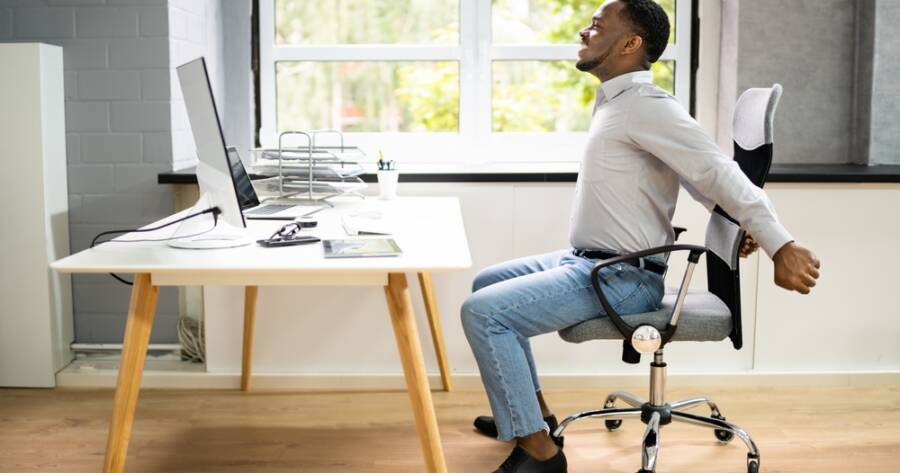Hours at a desk can take a quiet toll on your body. Long periods of sitting tighten muscles, slow circulation, and sap energy—all without you realizing it. A few short movement breaks throughout the day can counteract stiffness, restore focus, and even lift your mood. You don’t need a gym or special equipment; your workspace is enough. Simple desk exercises keep your body active, your mind sharp, and your energy levels steady from morning to evening.
Stretch Your Neck and Shoulders Regularly
Neck and shoulder tension is one of the first signs of desk fatigue. Spending hours hunched over a keyboard or phone strains the muscles that support posture. To loosen tightness, gently tilt your head toward one shoulder, hold for 10 seconds, then switch sides. Roll your shoulders backward and forward to relieve built-up tension.
Between emails or meetings, clasp your hands behind your back and stretch your chest open. This reverses the rounded posture that often comes from leaning forward. These small movements boost blood flow and ease stiffness without drawing attention in an office setting. A few minutes of mindful stretching every hour makes a noticeable difference by the end of the day.
Engage Core Muscles with Seated Exercises
You don’t need to leave your chair to build strength. Engaging your core while sitting supports posture and helps prevent lower back pain. Start by sitting tall with feet flat on the floor and shoulders relaxed. Gently tighten your abdominal muscles as if bracing for a laugh, hold for five seconds, and release. Repeat 10–15 times.
For a deeper challenge, try seated leg lifts: extend one leg straight, hold briefly, then lower slowly. Alternate legs to activate core and thigh muscles. You can also add small twists by rotating your torso gently from side to side while keeping your hips steady. These quick, subtle movements keep your core engaged and your spine supported—all without leaving your desk chair.
Boost Circulation with Standing Moves
Standing exercises wake up your body and counteract the effects of prolonged sitting. Stand up and take a few minutes to move every 30 to 60 minutes. March in place, roll your ankles, or do gentle calf raises by lifting your heels off the ground. These motions encourage circulation and reduce swelling in your legs and feet.
If your workspace allows, add squats or standing stretches. Even light movement helps deliver oxygen to your muscles and brain, improving alertness. You can also take short walking breaks during calls or between tasks. Standing regularly throughout the day not only reduces stiffness but also improves focus, mood, and long-term cardiovascular health.
Open Up Your Hips and Lower Back
Sitting for long stretches shortens hip flexors and tightens the lower back. Simple stretches can restore flexibility and ease discomfort. Try the seated figure-four stretch: cross one ankle over the opposite knee, keeping your back straight, and gently lean forward until you feel the stretch through your hip and glute. Hold for 15–20 seconds on each side.
To loosen your lower back, scoot forward in your chair, place your hands on your knees, and slowly arch and round your spine like a seated cat-cow stretch. These movements release pressure and keep your spine supple. Incorporating hip and back stretches even a few times a day helps reduce fatigue and improves how you feel when you stand up to leave work.
Refresh Your Energy with Upper-Body Mobility
Energy slumps are often physical as much as mental. Moving your upper body helps re-energize both. Interlace your fingers and reach your arms overhead for a full-body stretch, lengthening through your spine. Follow with gentle torso twists to each side to stimulate circulation and release tightness in the ribs and shoulders.
You can also do desk push-ups using the edge of your workspace—step back slightly, place your hands on the desk, and lower your chest toward it before pushing back up. This boosts heart rate and posture simultaneously. A few minutes of upper-body movement recharges your energy levels, refocuses your mind, and helps break up long, sedentary periods.
Movement as a Daily Reset
Desk exercises aren’t about working out—they’re about staying well. Movement keeps energy flowing, joints flexible, and focus sharp, even during long workdays. When you build short activity bursts into your schedule, you’ll notice fewer aches, better posture, and more alertness. The best part is how simple it is—five minutes every hour can transform how your body feels by the end of the day. With consistent micro-movements, your desk becomes not just a workspace but a place of balance and vitality.

